

| 1-800-871-4350 |
 |
 |
 |
 |
 |
 |
 |
 |
 |
 |
| NARCONON FACTS |
|
Narconon graduates are brought back to life, confident, in control and able to achieve their goals without the use of drugs.
Family members often try to protect an addict from the results of his behavior by making excuses to others about his addiction problem and by getting him out of drug-related jams. When conventional drug rehabilitation methods are not working with a drug-addicted person, there are effective drug rehabilitation alternatives to pursue before one gives up. Narconon provides a specific course of drug rehabilitation treatment which includes training in communication, a full body detoxification process, counseling in problem identification and solving, as well as counseling in personal values and integrity. |
| RESOURCES |
 |
Ecstasy
Information MDMA
(3, 4-Methylenedioxymethamphetamine), commonly referred to as Ecstasy, is a psychoactive
drug possessing stimulant and hallucinogenic properties. MDMA possesses chemical
variations of the stimulant amphetamine or methamphetamine and a hallucinogen,
most often mescaline. MDMA
was first synthesized in 1912 by a German company possibly to be used as an appetite
suppressant. Chemically, it is an analogue of MDA, a drug that was popular in
the 1960s. In the late 1970s, MDMA was used to facilitate psychotherapy by a small
group of therapists in the United States. Illicit use of the drug did not become
popular until the late 1980s and early 1990s. Ecstasy
is taken orally, usually in tablet or capsule form, and its effects last approximately
four to six hours. Users of the drug say that it produces profoundly positive
feelings, empathy for others, elimination of anxiety, enhancement of the senses,
and extreme relaxation. Ecstasy is also said to suppress the need to eat or sleep,
enabling users to endure two- to three-day parties. Consequently, Ecstasy use
sometimes results in severe dehydration or exhaustion. While it is not as addictive
as heroin or cocaine, ecstasy can cause other adverse effects including nausea,
hallucinations, chills, sweating, increases in body temperature, tremors, involuntary
teeth clenching, muscle cramping, and blurred vision. Ecstasy users also report
after-effects of anxiety, paranoia, and depression. An ecstasy overdose is characterized
by high blood pressure, faintness, panic attacks, and, in more severe cases, loss
of consciousness, seizures, and a drastic rise in body temperature. Ecstasy overdoses
can be fatal, as they may result in heart failure or extreme heat stroke. Ecstasy
is most often distributed at late-night parties called "raves," nightclubs,
and rock concerts. As the rave and club scene expands to metropolitan and suburban
areas across the country, ecstasy use and distribution are increasing as well.
Ecstasy is often used in combination with other substances. Once a person begins
using Ecstasy or begins frequenting events where Ecstasy is widely used, a vast
array of drugs become accessible as well. Ecstasy users often seek to increase
their high by combining their pill with a dose of marijuana, LSD, ketamine, GHB,
amphetamines, cocaine, or heroin. This experimentation can lead to addiction. What
is ecstasy? MDMA
or ecstasy is a Schedule I synthetic, psychoactive drug possessing stimulant and
hallucinogenic properties. Ecstasy possesses chemical variations of the stimulant
amphetamine or methamphetamine and a hallucinogen, most often mescaline. Commonly
referred to as Ecstasy or XTC, MDMA was first synthesized in 1912 by a German
company possibly to be used as an appetite suppressant. Chemically, it is an analogue
of MDA, a drug that waspopular in the 1960s. In the late 1970s, MDMA was used
to facilitate psychotherapy by a small group of therapists in the United States.
Illicit use of the drug did not become popular until the late 1980s and early
1990s. Ecstasy is frequently used in combination with other drugs. However, it
is rarely consumed with alcohol, as alcohol is believed to diminish its effects.
It is most often distributed at late-night parties called "raves," nightclubs,
and rock concerts. As the rave and club scene expands to metropolitan and suburban
areas across the country, ecstasy use and distribution are increasing as well.
How
is Ecstasy Used? Ecstasy
is most often available in tablet form and is usually ingested orally. It is also
available as a powder and is sometimes snorted and occasionally smoked, but rarely
injected. Its effects last approximately four to six hours. Users of the drug
say that it produces profoundly positive feelings, empathy for others, elimination
of anxiety, and extreme relaxation. Ecstasy is also said to suppress the need
to eat, drink, or sleep, enabling users to endure two- to three-day parties. Consequently,
ecstasy use sometimes results in severe dehydration or exhaustion. Where
does ecstasy come from? Clandestine
laboratories operating throughout Western Europe, primarily the Netherlands and
Belgium, manufacture significant quantities of the drug in tablet, capsule, or
powder form. Although the vast majority of ecstasy consumed domestically is produced
in Europe, a limited number of ecstasy labs operate in the United States. In addition,
in recent years, Israeli organized crime syndicates, some composed of Russian
émigrés associated with Russian organized crime syndicates, have
forged relationships with Western European traffickers and gained control over
a significant share of the European market. The Israeli syndicates are currently
the primary source to U.S. distribution groups. Overseas
ecstasy trafficking organizations smuggle the drug in shipments of 10,000 or more
tablets via express mail services, couriers aboard commercial airline flights,
or, more recently, through air freight shipments from several major European cities
to cities in the United States. The drug is sold in bulk quantity at the mid-wholesale
level in the United States for approximately eight dollars per dosage unit. The
retail price of ecstasy sold in clubs in the United States remains steady at twenty
to thirty dollars per dosage unit. Ecstasy traffickers consistently use brand
names and logos as marketing tools and to distinguish their product from that
of competitors. The logos are produced to coincide with holidays or special events.
Among the more popular logos are butterflies, lightning bolts, and four-leaf clovers Like
other drug addictions, heroin can become the most important aspect of their lives.
Heroin addicts often have habits that cost $100-$200 a day, which can cause addicts
to quickly turn to lives of shoplifting, burglary, theft, drug dealing, and prostitution
to support their habits. Methadone is a drug that has been used for several decades
to treat heroin addiction by blocking heroin�s effects. Methadone generally entails
the entire spectrum of opioid side effects, including the development of tolerance
and physical and psychological dependence. A
generation ago, the heroin (colloquially known as "smack") available in the U.S.
was barely five percent pure and used by a relatively small percentage of young
people because it had to be injected with a needle. Now, it appears smack is back
with a vengeance and addiction to heroin is being experienced by large groups
of new users. The
Office of National Drug Control Policy issued a report (April 1992, No. 5, pp.
1-6) claiming "a massive increase in heroin use and addiction is not likely."
One reason for this was, "...the apparent absence of new initiates (i.e., heroin
users with little or no prior drug-using experience)." However, based upon recent
news reports and other sources (see the A.T. Forum Web site for News Updates),
the ONDCP report appears to have been premature, to say the least. Just
this past February, Attorney General Janet Reno admitted heroin is more plentiful,
purer, and less expensive than it was just a few years ago. "If we do not counteract
the heroin threat now," she said, "we risk repeating the terrible consequences
of the 1980s' cocaine and crack epidemic." Authorities estimate that heroin addiction
has increased 20 percent and worldwide production has grown sharply, even as other
illegal substance abuse is declining. Reports
of problems have sprung-up nationwide. In California, heroin sold in the San Joaquin
Valley is cheap, potent, and plentiful - business is booming in area emergency
rooms as two or three overdose cases appear each day. In Colorado, Boulder County
officials may establish a methadone clinic for the first time in 16 years to deal
with increasing heroin addiction. On the East Coast, heroin is reported to be
40 to 70 percent pure and around $10 for a small packet. The number of heroin-related
hospital emergencies has more than doubled in New York City and surrounding areas.
Many
drug abusers mistakenly believe inhaling heroin, rather than injecting it, reduces
the risks of addiction or overdose. In some areas, "shabanging" - picking up cooked
heroin with a syringe and squirting it up the nose - has increased in popularity.
Street heroin carries prophetic names: "DOA," "Body Bag," "Instant Death," and
"Silence of the Lamb." Rather than scaring off young initiates, the implied danger
seems to actually increase the drug's allure. Symptoms
of Marijuana Addiction: Marijuana
is both emotionally and mentally addictive. Once an individual becomes addicted
to marijuana it develops into part of who they believe themselves to be. Avoiding
their friends who do not use, the addict will gravitate to others that do. Marijuana
is a topic that is always on their mind, whether it be thinking about the next
time they will be able to get high or where their going to get their next sack.
When someone is addicted to marijuana eventually their friends and the people
close to them only know how they act when their stoned because they no longer
do anything without first smoking. Their constant abuse is due to the misconception
that marijuana is what they need to solve their problems. Sometimes addicts will
take their stash with them wherever they go, just in case an opportunity arises
and they are able to take a couple hits. They may even go through several dealers
in order to make sure they always have a constant supply of marijuana. If
you feel that your marijuana use is out of your control and interfering with your
personal goals and happiness and you would like to stop but can't seek help from
addiction treatment professional. Methamphetamine
is a powerfully addictive stimulant that dramatically affects the central nervous
system. The drug is made easily in clandestine laboratories with relatively inexpensive
over-the-counter ingredients. These factors combine to make methamphetamine a
drug with high potential for widespread abuse. Methamphetamine
is commonly known as "speed," "meth," and "chalk." In its smoked form it is often
referred to as "ice," "crystal," "crank," and "glass." It is a white, odorless,
bitter-tasting crystalline powder that easily dissolves in water or alcohol. The
drug was developed early in this century from its parent drug, amphetamine, and
was used originally in nasal decongestants and bronchial inhalers. Methamphetamine's
chemical structure is similar to that of amphetamine, but it has more pronounced
effects on the central nervous system. Like amphetamine, it causes increased activity,
decreased appetite, and a general sense of well-being. The effects of methamphetamine
can last 6 to 8 hours. After the initial "rush," there is typically a state of
high agitation that in some individuals can lead to violent behavior. Methamphetamine
is a Schedule II stimulant, which means it has a high potential for abuse and
is available only through a prescription that cannot be refilled. There are a
few accepted medical reasons for its use, such as the treatment of narcolepsy,
attention deficit disorder, and -- for short-term use -- obesity; but these medical
uses are limited. What
is the scope of methamphetamine use in the United States? Methamphetamine
abuse, long reported as the dominant drug problem in the San Diego, CA, area,
has become a substantial drug problem in other sections of the West and Southwest,
as well. There are indications that it is spreading to other areas of the country,
including both rural and urban sections of the South and Midwest. Methamphetamine,
traditionally associated with white, male, blue-collar workers, is being used
by more diverse population groups that change over time and differ by geographic
area. According
to the 1996 National Household Survey on Drug Abuse, an estimated 4.9 million
people (2.3 percent of the population) have tried methamphetamine at some time
in their lives. In 1994, the estimate was 3.8 million (1.8 percent), and in 1995
it was 4.7 million (2.2 percent). Data
from the 1996 Drug Abuse Warning Network (DAWN), which collects information on
drug-related episodes from hospital emergency departments in 21 metropolitan areas,
reported that methamphetamine-related episodes decreased by 39 percent between
1994 and 1996, after a 237 percent increase between 1990 and 1994. There was a
statistically significant decrease in methamphetamine-related episodes between
1995 (16,200) and 1996 (10,800). However, there was a significant increase of
71 percent between the first half of 1996 and the second half of 1996 (from 4,000
to 6,800). NIDA's
Community Epidemiology Work Group (CEWG), an early warning network of researchers
that provides information about the nature and patterns of drug use in major cities,
reported in its June 1997 publication that methamphetamine continues to be a problem
in Hawaii and in major Western cities, such as San Francisco, Denver, and Los
Angeles. Increased methamphetamine availability and production are being reported
in diverse areas of the country, particularly rural areas, prompting concern about
more widespread use. Methamphetamine
and amphetamine use is on the rise Drug
abuse treatment admissions reported by the CEWG in December 1996 showed that methamphetamine
remained the leading drug of abuse among treatment clients in the San Diego area
and was second only to marijuana in Hawaii. Stimulants, including methamphetamine,
accounted for smaller percentages of treatment admissions in other states and
metropolitan areas of the West (e.g., 5 percent in Los Angeles and Seattle and
4 percent in Texas and San Francisco). By comparison, stimulants were the primary
drugs of abuse in less than 1 percent of treatment admissions in most Eastern
and Midwestern metropolitan areas, except in Minneapolis-St. Paul and St. Louis,
where they accounted for approximately 2 percent of total admissions. Where
did methadone come from? Methadone
Hydrochloride is an opioid (a synthetic opiate) that was originally synthesised
by German pharmaceutical companies during the second world war. It was first marketed
as 'Dolophine' (to honour Adolph Hitler) and was used as an analgesic (a painkiller)
for the treatment of severe pain. It is still occasionally used for pain relief.
Methadone
is now primarily used today for the treatment of narcotic addiction. The effects
of methadone are longer-lasting than those of morphine-based drugs. Methadone's
effects can last up to 24 hours, thereby permitting administration only once a
day in heroin detoxification and maintenance programs. How
is methadone taken? Methadone
is usually available as a liquid - linctus or methadone mixture - which should
be swallowed. Tablets and injectable ampoules are sometimes prescribed, and like
many other medicines some of these prescribed drugs are diverted and become available
illegally. What
are methadone's adverse reactions? Deaths
occur more frequently at the beginning of treatment in methadone programs; they
are usually a cause of excessive doses (i.e. erroneously estimated tolerance)
and they are affected by concomitant diseases (hepatitis, pneumonia). Methadone
generally entails the entire spectrum of opioid side effects, including the development
of tolerance and physical and psychological dependence. Respiratory depressions
are dangerous. The released histamines can cause hypotension or bronchospasms.
Other symptoms are: constipation, nausea or vomiting, sedation, vertigo, edema.
What
are the symptoms of methadone overdose? Body
as a whole Respiratory
Eyes,
ears, nose, and throat Gastrointestinal Heart
and blood vessels Nervous
system What
is methadone dependency? As
an opiate, regular use of methadone causes physical dependency - if you've been
using it regularly (prescribed or not) once you stop you will experience a withdrawal.
The physical changes due to the drug are similar to other opiates (like heroin);
suppressed cough reflex, contracted pupils, drowsiness and constipation. Some
methadone users feel sick when they first use the drug. If you are a woman using
methadone you may not have regular periods - but you are still able to conceive.
Methadone is a long-acting opioid; it has an effect for up to 36 hours (if you
are using methadone you will not withdraw for this period) and can remain in your
body for several days. Personal
stories of methadone withdrawal: ~I've
been on both ends of withdrawals, heroin and methadone, every patient of methadone
will always tell you the same, as I do; I can kick heroin anytime, but methadone
that is something else. In 15 yrs of heroin addiction, I've kicked 3 times, 'cold-turkey'.
In 10 years on methadone I've never kicked methadone. Once
I landed in jail, I had to do 72 hours of jail time before I got to see the judge.
I was literally on the floor screaming my guts out. About 12 hours before I was
to see the judge, I demanded to be taken to the hospital, I just couldn't take
it. I was cuffed, and looking like a 'chair' was glued to my back, I limped to
the ambulence, since I couldn't lift my leg to climb into the back, the police
grabbed me on both sides and shoved me in like a sack of potatoes, I fell flat
on my face. The doctor realizing my condition and that it was severe, gave me
a shot of methadone. The relief was immediate. I
was returned to the precinct and 2 days later I was in the same condition! Never
did I go through such hell in all my days. The
intensity of methadone withdrawal is just too much! I could never do it, by the
way, about 5 years ago one inmate went into convulsions and upon falling, he hit
the metal bars and died! My
doctor, an anesthesiologist, writes prescriptions for 125 tablets. This lasts
15 days. I signed a contract with him that basically says I will use the same
pharmacy, I will not get meds from other physicians, and if I run out before the
15 days is up I just have to go without. I didn't mind signing the contract at
all, and I have abided by all the stipulations. I called him for a refill on Friday.
No response. I called again on Saturday. No response. I called his home on Sunday.
No response. On Sunday I took my last dose. I hate anything having this much control
over me. I find it very demeaning to be so dependent on a bottle of pills. On
Monday I called his office. They informed me that he was on vacation this week.
Panic descended . . . and so did withdrawal symptoms. At first I just got kinda
nervous, jittery. My doctor has told me that methadone is not addicting. That
is contrary to everything and anything I've ever heard or read about the drug.
I never questioned him why he thought methadone wasn't addicting. I was hoping
I'd never have to find out. What my body went through for the next 48 hours was
one severe blow after another. I kept trying to tell myself I just had the flu.
Just crawl in bed for 3 days and sweat it out. Of course I knew this wasn't true
but I was going to play whatever mind game it took to get me through this. After
the jitters, the muscle contractures started. It felt like the muscles in my legs
and then in my arms were like rubber bands, being stretched and pulled to their
max and then constricting to a shape that wasn't natural. Then came the sweats,
diarrhea, hallucinations. I
remember trying to dial the phone. It was a number I've called a thousand times
before, only now I couldn't remember it. For that matter, I couldn't even hold
the phone . . . I kept dropping it. My muscles were out of control. The pain that
led me to methadone returned with a vengeance. In a strange way it was like an
old friend. I knew it well and understood it completely. The combination of withdrawal
and pain was too much. The all too familiar thoughts of suicide were returning.
It
was now Tuesday morning. I called the pharmacist and explained the situation.
By 1:10 PM I had 8 methadone tablets. I took the entire dose at once all 8 tablets.
Within 2 hours my muscles had stopped screaming, my head was beginning to clear,
and the pain was lessening. It's
now Thursday morning. I'm still not back to myself . .. . but much better. The
assault on my body was indeed very traumatic . . . I lost 7 pounds and am still
very shaky. Addiction is indeed a dangerous thing and should be avoided. I must
admit when I was in the throes of withdrawal there's not much I wouldn't have
done to relieve the symptoms. What
are the dangers of methadone? Following
is an article by two doctors addressing this question By
Drs Marcel Buster & Giel van Brussel, MD Based
on literature and analysis of mortality figures Dr Russell Newcombe concluded
that methadone programmes as a form of harm-reduction possibly cause more victims
than they prevent. We have doubts whether the conclusionabout methadone is fully
justified. Looking at the mentioned literature gives a one-sided view at the problem.
Moreover, the conclusions drawn are beyond those justified by the results of the
analyses. Several points of debate come to mind: Methadone
is not an innocent substance; 'one's methadone maintenance dose is another's poison'
(2). A regular user of opiates develops a certain tolerance. Therefore, it is
possible that a tolerant person can function normally with dosages which can be
fatal to a non-tolerant person. Also, methadone dosage in the case of first entry
to the programme has to be evaluated carefully. It is wise to begin with a low
dosage that has to be increased slowly in the course of weeks or even months.
At entry to the programme it has to be carefully evaluated whether a patient has
a clear and unambiguous heroin dependence. In methadone maintenance programmes,
methadone is dispensed to tolerant persons, moreover, this tolerance remains high
because of daily use of methadone. Therefore, it is not surprising that deaths
at the King's College Hospital caused by methadone were not those of participants
of a methadone maintenance programme but were those of 'recreational' users of
illicit methadone. In
cases where more than one drug is used, the drug responsible for death due to
overdose is difficult to establish. Moreover, the same drug prescribed by physicians
can also be bought on the street. In seventy percent of the deaths due to overdose
studied in Glasgow and Edinburgh a combination of different drugs was found (3). Prescribed
drugs such as temazepam were often encountered in deaths in Glasgow. However,
among only 14 of the 34 persons who died in 1992 and where temazepam was found,
this was prescribed by their physician. Because of the presence of other drugs
it is not clear whether temazepam really caused the death of these people. Probably
the combination of these different drugs was fatal to them. This was also the
case with the methadone deaths in Edinburgh. However, in Edinburgh, the authors
could not determine whether methadone was prescribed or not. Both Hammersley and
Obafunwa report that heroin/morphine deaths seldom occur in Edinburgh (4). 'The
fall of the deaths due to overdose in the Lothian and Borders Region of Scotland
(LBRS) after 1984 reflects in part the strict policing that took place, in particular
in the Edinburgh area'. 'The
increase of methadone deaths is probably due to the introduction of a street trend
to use this agent as a substitute to heroin'. The author suggests that methadone
deaths are mainly caused by the use of illicit methadone. Therefore,
these figures suggest that participants of methadone programmes are at lower risk
of death due to overdose. However, this does not mean that methadone is an innocent
substance. The high and increasing number of methadone deaths in Britain is alarming
and certainly needs more attention. The first priority should be to establish
whether the methadone causing death has been prescribed within a methadone programme
or bought on the street. It also should be evaluated at what point during the
course of the methadone programme death takes place. Further instruction doctors
prescribing methadone could be necessary. The use of non-prescribed methadone
without medical supervision can lead to high risks, especially when it is used
as a substitute for heroin in order to get a 'high' instead of to prevent withdrawal
symptoms. Physicians have to be aware of this danger and they should make sure
that the prescribed methadone (as well as other psycho-active drugs) does not
end up in the 'grey market'. Attempts
to stop using the drugs can fail simply because the resulting depression can be
overwhelming, causing the addict to use more cocaine in an attempt to overcome
his depression. This overpowering addiction can cause the addict to do anything
to get cocaine. Recent
studies on cocaine and addiction have shown that, during periods of abstinence
from cocaine use, the memory of the euphoria associated with cocaine, or mere
exposure to cues associated with cocaine use, can trigger tremendous craving and
relapse to cocaine, even after long periods of abstinence. Researchers
have found that cocaine stimulates the brain's reward system inducing an even
greater feeling of pleasure than natural functions. In turn, its influence on
the reward circuit can lead a user to bypass survival activities and repeat drug
use. Chronic cocaine use can lead to a cocaine addiction and in some cases damage
the brain and other organs. An addict will continue to use cocaine even when faced
with adverse consequences. Cocaine and crack cocaine continue to be the most frequently
mentioned illicit substance in U.S. emergency departments (ED), present in 30%
of ED drug episodes during 2001. From 2000 to 2001, the number of ED cocaine mentions
increased ten percent from 174,881 in 2000 to 193,034 in 2001. "Crack"
is the street name given to cocaine that has been processed from cocaine hydrochloride
to a free base for smoking. Crack cocaine looks like white to tan pellets or chunks
that resemble rock salt or soap. Rather than requiring the more volatile method
of processing cocaine using ether, crack cocaine is processed with ammonia or
sodium bicarbonate (baking soda) and water and heated to remove the hydrochloride,
thus producing a form of cocaine that can be smoked. The term "crack" refers to
the crackling sound heard when the mixture is smoked (heated), presumably from
the sodium bicarbonate. Research studies regarding crack and addiction, has shown
crack to have more addictive properties than cocaine. This is due to its chemical
makeup and method of use. Oxycontin
addiction is a physical dependence that is unavoidable when an individual is exposed
to high doses of the drug for a extended period of time. The body then adapts
and develops a tolerance for Oxycontin. The addiction is so powerful that it produces
cravings. These cravings for Oxycontin are the result of its impact on the individual's
memory with feelings of pleasantness and euphoria which the individual has come
to associate with the taking of Oxycontin. The subconscious memory then motivates
the individual to seek this drug because of its false imprint of Oxycontin. Oxycontin,
like other addictive prescription drugs is able to short-circuit your survival
system. It artificially stimulates the reward center, or pleasure areas in your
brain, without anything beneficial happening to your body. As this happens, it
leads to increased confidence in Oxycontin, and less confidence in the normal
rewards of life. In
addition to the psychological addiction of Oxycontin there is also a physical
addiction. Overtime the individual no longer experiences the same feeling of euphoria
they once did but still continue to use because the pain that they suffer is far
to great with out it. Individuals addicted to Oxycontin suffer: cold sweats, diarrhea,
insomnia, muscle pain / bone pain, restlessness, involuntary leg movement, vomiting,
nausea and severe stomach cramps without Oxycontin in their system. Once
the individual is addicted their interests decrease in other aspects of their
life as they increase their reliance on Oxycontin. People, places and activities
or lifestyles that that worked through their normal reward system, before using
Oxycontin become less important. Overtime individuals heavily addicted to Oxycontin
will begin to resent people, places, and activities that do not fit with their
drug abusing lifestyle. Individuals
with an addiction to Oxycontin obtain the drug in a variety of ways including
pharmacy diversion, "Doctor Shopping" and improper prescribing practices
by physicians. Pharmacy diversion occurs when the pharmacy staff takes the Oxycontin
directly from the shelves, or when people make fraudulent prescriptions. The
most widely used diversion technique of those with an addiction to Oxycontin at
the street level is doctor shopping. Individuals who may or may not have a legitimate
ailment requiring a doctors prescription for controlled substances, visit numerous
doctors, sometimes in several states, to acquire large amounts of Oxycontin which
they abuse or sell to others who share their addiction. Another
way Oxycontin is obtained is through improper prescribing practices by unscrupulous
physicians. According to law enforcement sources survey by the NDIC the abuse
of Oxycontin, as with the abuse of most prescription drugs, creates a cycle of
health care fraud. For example, a corrupt physician writes an addicted patient
a prescription for Oxycontin for a nonexistent injury. The physician bills the
insurance company for that, and subsequent, visits. The patient uses a portion
of the Oxycontin and sells the rest for a substantial profit. Oxycontin addiction
has led to an increased number of pharmacy robberies, thefts, shoplifting incidents,
and health care fraud incidents.
The
effects of long-term ecstasy use are just beginning to undergo scientific analysis.
In 1998, the National Institute of Mental Health conducted a study of a small
group of habitual ecstasy users who were abstaining from use. The study revealed
that the abstinent users suffered damage to the neurons in the brain that transmit
serotonin, an important biochemical involved in a variety of critical functions
including learning, sleep, and integration of emotion. The results of the study
indicate that recreational ecstasy users may be at risk of developing permanent
brain damage that may manifest itself in depression, anxiety, memory loss, and
other neuropsychotic disorders.  Heroin
addiction like all opiate addictions occurs when heroin is administered over a
sustained period of time. The onset of heroin addiction can be both rapid and
severe, dependent on the amount used and frequency in a designated period of time.
Heroin addicts will "crave" more of the drug and experience withdrawal symptoms
if they do not get their regular "fix" or dose. Not all of the mechanisms by which
heroin and other opiates affect the brain are known. Likewise, the exact brain
mechanisms that cause tolerance and addiction are not completely understood. Heroin
stimulates a "pleasure system" in the brain. This system involves neurons in the
mid-brain that use the neurotransmitter called "dopamine." These mid-brain dopamine
neurons project to another structure called the nucleus accumbens which then projects
to the cerebral cortex. This system is responsible for the pleasurable effects
of heroin and for the addictive power of the drug.
Heroin
addiction like all opiate addictions occurs when heroin is administered over a
sustained period of time. The onset of heroin addiction can be both rapid and
severe, dependent on the amount used and frequency in a designated period of time.
Heroin addicts will "crave" more of the drug and experience withdrawal symptoms
if they do not get their regular "fix" or dose. Not all of the mechanisms by which
heroin and other opiates affect the brain are known. Likewise, the exact brain
mechanisms that cause tolerance and addiction are not completely understood. Heroin
stimulates a "pleasure system" in the brain. This system involves neurons in the
mid-brain that use the neurotransmitter called "dopamine." These mid-brain dopamine
neurons project to another structure called the nucleus accumbens which then projects
to the cerebral cortex. This system is responsible for the pleasurable effects
of heroin and for the addictive power of the drug. 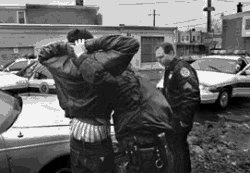
 Marijuana
addiction is a phenomenon experienced by more than 150,000 individuals each year
who enter treatment for their proclaimed addiction to marijuana. Marijuana addiction
is characterized as compulsive, often uncontrollable marijuana craving, seeking,
and use, even when the individual knows that marijuana use is not in his best
interest. Marijuana addiction could be defined as chronically making the firm
decision not to use marijuana followed shortly by a relapse due to experiencing
overwhelming compulsive urges to use marijuana despite the firm decision not to.
This contradiction is characteristic of an addiction problem.
Marijuana
addiction is a phenomenon experienced by more than 150,000 individuals each year
who enter treatment for their proclaimed addiction to marijuana. Marijuana addiction
is characterized as compulsive, often uncontrollable marijuana craving, seeking,
and use, even when the individual knows that marijuana use is not in his best
interest. Marijuana addiction could be defined as chronically making the firm
decision not to use marijuana followed shortly by a relapse due to experiencing
overwhelming compulsive urges to use marijuana despite the firm decision not to.
This contradiction is characteristic of an addiction problem.
Either need for markedly increased amounts of marijuana to achieve
intoxication, or markedly diminished effect with continued use of the same amount
of marijuana.
Marijuana taken in larger amounts or over
a longer period than was intended
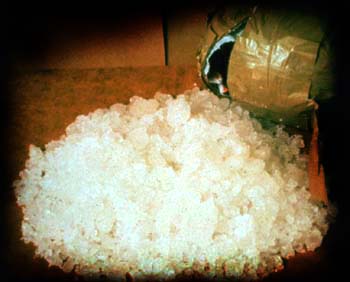
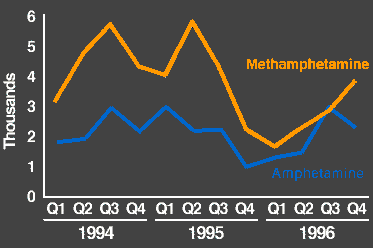
Quarterly emergency room episodes due to stimulant
use were tracked from 1994 to 1996. A shortage of methamphetamine was reported
by epidemiologists during the last half of 1995 accounting for the significant
decrease in ER episodes. 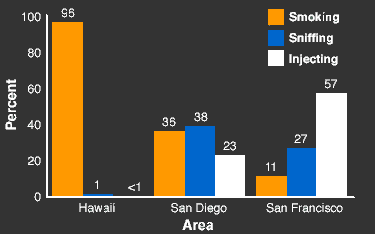
Muscle
spasticity
Difficulty
breathing Slow,
shallow and labored breathing Stopped
breathing (sometimes fatal within 2-4 hours)
Pinpoint
pupils Bluish
skinBluish
fingernails and lips
Spasms
of the stomach and/or intestinal tract Constipation
Low
blood pressure
Drowsiness
Disorientation
Coma
~On
Sunday morning, March 30, I took my last dose of methadone. I have been on 80
mgs of methadone for the past 6 months.
Is methadone
more likely to kill you than heroin?
Municipal Health Service Amsterdam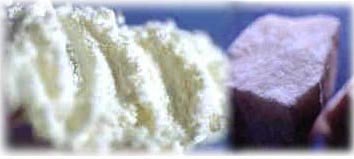 Cocaine
addiction can occur very quickly and be very difficult to break. Animal studies
have shown that animals will work very hard (press a bar over 10,000 times) for
a single injection of cocaine, choose cocaine over food and water, and take cocaine
even when this behavior is punished. Animals must have their access to cocaine
limited in order not to take toxic or even lethal doses. People addicted to cocaine
behave similarly. They will go to great lengths to get cocaine and continue to
take it even when it hurts their school or job performance and their relationships
with loved ones.
Cocaine
addiction can occur very quickly and be very difficult to break. Animal studies
have shown that animals will work very hard (press a bar over 10,000 times) for
a single injection of cocaine, choose cocaine over food and water, and take cocaine
even when this behavior is punished. Animals must have their access to cocaine
limited in order not to take toxic or even lethal doses. People addicted to cocaine
behave similarly. They will go to great lengths to get cocaine and continue to
take it even when it hurts their school or job performance and their relationships
with loved ones.

| Quote |

 |
| Link
to Us! |
Show your support, link to us! |
 Funding pledged to fight drug abuse
Funding pledged to fight drug abuse
